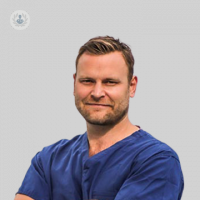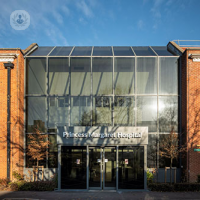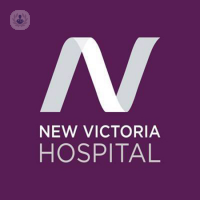What is a sprain?
Sprains and strains are common injuries that affect muscles and ligaments and usually occur at the wrist, hand, ankle or leg. It can take about two weeks for a sprain to improve, with some taking a few months to fully recover.

What are the symptoms of a sprain?
Common symptoms of a sprain include:
- Pain and tenderness around the area sprained, often the ankle, foot, wrist, knee and leg
- Swelling and bruising
- The sprained part of your body cannot be used as normal or carry much weight
- Muscle spasms or cramps
What causes a sprain?
Sprains can happen when you:
- Overstretch or twist a muscle
- Don’t warm up before exercising
- Have tired muscles
- Playing sports
How is a sprain diagnosed?
Sprains can be diagnosed with your GP, however, if you feel pain and inflammation after playing sports or twisting and find it hard to bare weight on that part of your body, then you more than likely have a sprain.
How is a sprain treated?
Most sprains can be treated at home, without intervention.
For the first few days following the sprain, the four steps of RICE therapy should be followed to help bring down the swelling and support the sprain.
1. Rest: avoid exercise and activities and don’t put any weight on the injury
2. Ice: apply ice or a bag of frozen vegetables to the injury for 20 minutes every two to three hours
3. Compression: wrap a bandage around the injury to give it support
4. Elevate: keep the injured muscle raised on a pillow as much as possible
It’s best to avoid heat, massages, hot baths and alcohol for the first few days. Even if exercise should be avoided, it’s recommended to keep moving the injured joint to avoid it becoming stiff. Strenuous exercise should not be carried out for at least eight weeks.
If pain worsens or doesn’t improve, visit your GP who will advise the next steps and suggest painkillers like paracetamol to ease the pain and ibuprofen to reduce inflammation. You may also be required to have an X-ray. Physiotherapy can help with sprains that are taking longer to heal.
If you suddenly get a high temperature and feel hot and shivery, you may have an infection and it is advised to call emergencies for advice.
05-02-2013
Sprain
What is a sprain?
Sprains and strains are common injuries that affect muscles and ligaments and usually occur at the wrist, hand, ankle or leg. It can take about two weeks for a sprain to improve, with some taking a few months to fully recover.

What are the symptoms of a sprain?
Common symptoms of a sprain include:
- Pain and tenderness around the area sprained, often the ankle, foot, wrist, knee and leg
- Swelling and bruising
- The sprained part of your body cannot be used as normal or carry much weight
- Muscle spasms or cramps
What causes a sprain?
Sprains can happen when you:
- Overstretch or twist a muscle
- Don’t warm up before exercising
- Have tired muscles
- Playing sports
How is a sprain diagnosed?
Sprains can be diagnosed with your GP, however, if you feel pain and inflammation after playing sports or twisting and find it hard to bare weight on that part of your body, then you more than likely have a sprain.
How is a sprain treated?
Most sprains can be treated at home, without intervention.
For the first few days following the sprain, the four steps of RICE therapy should be followed to help bring down the swelling and support the sprain.
1. Rest: avoid exercise and activities and don’t put any weight on the injury
2. Ice: apply ice or a bag of frozen vegetables to the injury for 20 minutes every two to three hours
3. Compression: wrap a bandage around the injury to give it support
4. Elevate: keep the injured muscle raised on a pillow as much as possible
It’s best to avoid heat, massages, hot baths and alcohol for the first few days. Even if exercise should be avoided, it’s recommended to keep moving the injured joint to avoid it becoming stiff. Strenuous exercise should not be carried out for at least eight weeks.
If pain worsens or doesn’t improve, visit your GP who will advise the next steps and suggest painkillers like paracetamol to ease the pain and ibuprofen to reduce inflammation. You may also be required to have an X-ray. Physiotherapy can help with sprains that are taking longer to heal.
If you suddenly get a high temperature and feel hot and shivery, you may have an infection and it is advised to call emergencies for advice.


Why is my ankle injury not healing
Mr Stefan Weitzel
2025-01-22
Ankle injuries are very common and while most are mild sprains and typically take 2-4 weeks to heal, some may take even longer. However, you should always be noticing a gradual improvement in your symptoms as time goes by, and if you aren't, it can indicate something more serious. Mr Stefan Weitzel, one of our top consultant orthopaedic surgeons, explains what you should do if you ankle injury doesn't show signs of healing. Mostrare di più
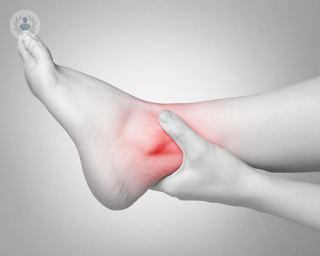

How long does a child’s sprained ankle take to heal?
Mr Darius Rad
2025-01-21
Have you recently noticed that your child has been struggling to bear their full leg weight on the ground? If so, they may have suffered an ankle sprain, and might require medical attention. Here, esteemed paediatric orthopaedic surgeon, Mr Darius Rad, provides with an all-we-need-to-know guide on ankle sprains in children. Mostrare di più


Your quick recovery guide to strains, sprains and breaks
Professor Ali Ghoz
2025-01-21
Injuries to joints, muscles, ligaments and bones happen to us all at some point in our lives. Professor Ali Ghoz, a consultant trauma and orthopaedic surgeon based in London, explains how to effectively manage these injuries and what to expect during the recovery period. Mostrare di più
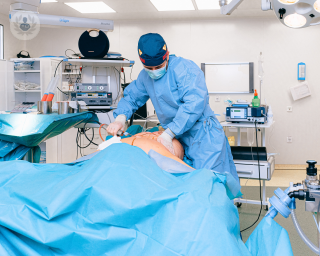

How is orthopaedic surgery being affected by COVID-19?
Mr Tarek El Gamal
2025-01-17
Accidents happen. And sometimes, these accidents need emergency care which could mean going into surgery. During the COVID-19 pandemic, it may be worrying no knowing how this crisis is affecting trauma-related hospital treatments and what your next steps are if you've hurt yourself. Mr Tarek El Gamal, an expert orthopaedic surgeon, explains more. Mostrare di più
Medici esperti in Distorsione
-
Mr Tim Sinnett
TraumatologiaEsperto in:
- Chirurgia del piede e della caviglia
- Fascite plantare
- Frattura del piede
- Tendinite
- Distorsione
- Artrosi della caviglia
-
Mr Jasdeep Giddie
TraumatologiaEsperto in:
- Lesioni traumatiche
- Cipolla (Alluce valgo)
- Lesioni sono danni
- Artrosi della caviglia
- Distorsione
- Piede diabetico
- Visualizzare tutti

The Princess Margaret Hospital - part of Circle Health Group
The Princess Margaret Hospital - part of Circle Health Group
Osborne Rd, Windsor SL4 3SJ
No existe teléfono en el centro.
Se utilizzi questo numero di Top Doctors autorizzi al trattamento dei dati a fini statistici e commerciali. Per maggiori informazioni, leggi la nostra l’informativa sulla privacy
Top Doctors

The Parkside Suite Wexham
The Parkside Suite Wexham
Wexham Park Hospital, SL2 4HL, Berkshire
No existe teléfono en el centro.
Se utilizzi questo numero di Top Doctors autorizzi al trattamento dei dati a fini statistici e commerciali. Per maggiori informazioni, leggi la nostra l’informativa sulla privacy
Top Doctors

New Victoria Hospital
New Victoria Hospital
184 Coombe Lane West, Kingston upon Thames, KT2 7EG
No existe teléfono en el centro.
Se utilizzi questo numero di Top Doctors autorizzi al trattamento dei dati a fini statistici e commerciali. Per maggiori informazioni, leggi la nostra l’informativa sulla privacy
Top Doctors
-
The Princess Margaret Hospital - part of Circle Health Group
Osborne Rd, Windsor SL4 3SJ, WindsorEsperto in:
- Brachiterapia
- Cardiologia
- Chirurgia generale
- Chirurgia ortopedica
- Chirurgia robotica
- Dermatologia
-
The Parkside Suite Wexham
Wexham Park Hospital, SL2 4HL, Berkshire, WexhamEsperto in:
- Chirurgia del colon-retto
- Chirurgia generale
- Chirurgia plastica
- Dermatologia
- Ginecologia e Ostetricia
- Oncologia medica
-
New Victoria Hospital
184 Coombe Lane West, Kingston upon Thames, KT2 7EG, South LondonEsperto in:
- Cardiologia
- Chirurgia generale
- Chirurgia ortopedica
- Chirurgia plastica
- Gestione del dolore
- Colonna vertebrale
- Visualizzare tutti
